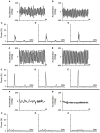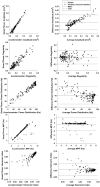Using a smart phone as a standalone platform for detection and monitoring of pathological tremors
- PMID: 23346053
- PMCID: PMC3548411
- DOI: 10.3389/fnhum.2012.00357
Using a smart phone as a standalone platform for detection and monitoring of pathological tremors
Abstract
Introduction: Smart phones are becoming ubiquitous and their computing capabilities are ever increasing. Consequently, more attention is geared toward their potential use in research and medical settings. For instance, their built-in hardware can provide quantitative data for different movements. Therefore, the goal of the current study was to evaluate the capabilities of a standalone smart phone platform to characterize tremor.
Results: Algorithms for tremor recording and online analysis can be implemented within a smart phone. The smart phone provides reliable time- and frequency-domain tremor characteristics. The smart phone can also provide medically relevant tremor assessments.
Discussion: Smart phones have the potential to provide researchers and clinicians with quantitative short- and long-term tremor assessments that are currently not easily available.
Methods: A smart phone application for tremor quantification and online analysis was developed. Then, smart phone results were compared to those obtained simultaneously with a laboratory accelerometer. Finally, results from the smart phone were compared to clinical tremor assessments.
Keywords: Parkinson; essential tremor; long-term; movement disorder; telemedicine; telephone; tremor.
Figures



Similar articles
-
Smart watch accelerometry for analysis and diagnosis of tremor.J Neurosci Methods. 2014 Jun 15;230:1-4. doi: 10.1016/j.jneumeth.2014.04.021. Epub 2014 Apr 23. J Neurosci Methods. 2014. PMID: 24769376
-
Measuring tremor with a smartphone.Methods Mol Biol. 2015;1256:359-74. doi: 10.1007/978-1-4939-2172-0_24. Methods Mol Biol. 2015. PMID: 25626551
-
Pedestrian self-reported use of smart phones: Positive attitudes and high exposure influence intentions to cross the road while distracted.Accid Anal Prev. 2017 Jan;98:338-347. doi: 10.1016/j.aap.2016.10.028. Epub 2016 Nov 5. Accid Anal Prev. 2017. PMID: 27825043
-
The Use of Smart phones in Ophthalmology.Acta Inform Med. 2014 Jun;22(3):206-9. doi: 10.5455/aim.2014.22.206-209. Epub 2014 Jun 15. Acta Inform Med. 2014. PMID: 25132717 Free PMC article. Review.
-
[Advances in the application of smart phones in modern medicine].Sheng Wu Yi Xue Gong Cheng Xue Za Zhi. 2014 Feb;31(1):222-7. Sheng Wu Yi Xue Gong Cheng Xue Za Zhi. 2014. PMID: 24804515 Review. Chinese.
Cited by
-
Diagnosis and Treatment of Tremor in Parkinson's Disease Using Mechanical Devices.Life (Basel). 2022 Dec 27;13(1):78. doi: 10.3390/life13010078. Life (Basel). 2022. PMID: 36676025 Free PMC article. Review.
-
Developing a smartphone application, triaxial accelerometer-based, to quantify static and dynamic balance deficits in patients with cerebellar ataxias.J Neurol. 2020 Mar;267(3):625-639. doi: 10.1007/s00415-019-09570-z. Epub 2019 Nov 11. J Neurol. 2020. PMID: 31713101 Clinical Trial.
-
Developing a Tool for Remote Digital Assessment of Parkinson's Disease.Mov Disord Clin Pract. 2015 Oct 20;3(1):59-64. doi: 10.1002/mdc3.12239. eCollection 2016 Jan-Feb. Mov Disord Clin Pract. 2015. PMID: 30363542 Free PMC article.
-
Upper limb intention tremor assessment: opportunities and challenges in wearable technology.J Neuroeng Rehabil. 2024 Jan 13;21(1):8. doi: 10.1186/s12984-023-01302-9. J Neuroeng Rehabil. 2024. PMID: 38218890 Free PMC article. Review.
-
A-WEAR Bracelet for Detection of Hand Tremor and Bradykinesia in Parkinson's Patients.Sensors (Basel). 2021 Feb 2;21(3):981. doi: 10.3390/s21030981. Sensors (Basel). 2021. PMID: 33540570 Free PMC article.
References
-
- Askari S., Zhang M., Won D. S. (2010). An EMG-based system for continuous monitoring of clinical efficacy of Parkinson’s disease treatments. Conf. Proc. IEEE Eng. Med. Biol. Soc. 2010, 98–101 - PubMed
-
- Barroso Junior M. C., Esteves G. P., Nunes T. P., Silva L. M., Faria A. C., Melo P. L. (2011). A telemedicine instrument for remote evaluation of tremor: design and initial applications in fatigue and patients with Parkinson’s disease. Biomed. Eng. Online 10, 14.10.1186/1475-925X-10-14 - DOI - PMC - PubMed
LinkOut - more resources
Full Text Sources
Other Literature Sources

